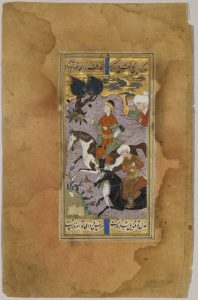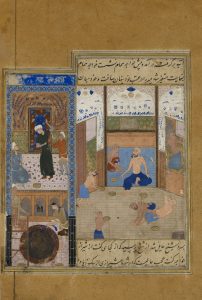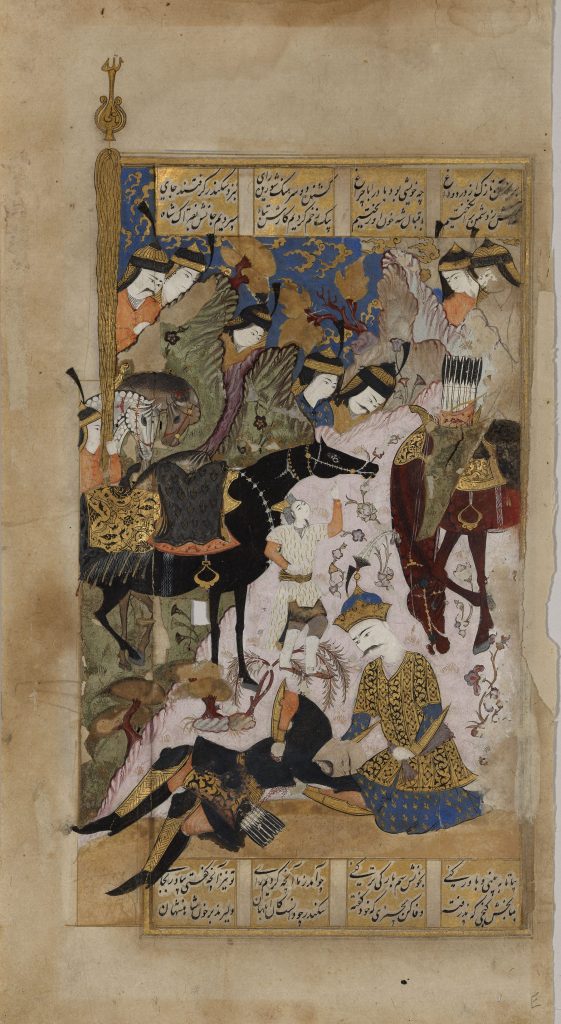 Iran, Qazvin, Safavid Empire. c. 1570 CE
Iran, Qazvin, Safavid Empire. c. 1570 CE
Hunt Scene in the Makhzan al-Asrar (Treasury of Secrets)
Folio from the Khamsa (Quintet) of Nizami Ganjavi (1141-1209)
Ink, opaque watercolors, and gold on paper
Gift of Elinor Lander Horwitz, class of 1950
SC 2016:29-12
Two lavishly-dressed men on horseback trot over a mountainous purple background in this hunt scene that was originally part of a manuscript of the Makhzan al-Asrār (Treasury of Secrets), the first book from Nizami’s 12th century Persian poetic epic the Khamsa. The Khamsa was commonly illustrated for centuries, including the scene from a 1638 copy that depicts a Prince in mourning (below, right).
The disproportionately large, rounded heads are placed upon slender necks and the figures’ joints are bent, both trademarks of the painting style from Qazvin, the 16th century capital of the Safavid empire. The organic background landscape of the hunt scene departs from the crisp architectural style popular in the empire’s previous capital, Tabriz, visible in the adjacent 1580s painting, Sa‘di Shirazi meeting Khvaja in Hammam al-Din bathhouse in Tabriz (below, left).
The paper’s rosy hue is the result of dyeing, a common Safavid artistic process. Safavid painters believed that white paper was harmful to the eyes and detracted from the painting.
Mollie Wohlforth, Mount Holyoke College ‘19

a;id
Right: Iran. c. 1638 CE
Prince mourning dying friend
Folio from a manuscript of the Iskandarnama in the Khamsa (Quintet) of Nizami Ganjavi (1141-1209)
Ink, opaque watercolors, and gold on paper
Gift of Elinor Lander Horwitz, class of 1950
SC 2016:29-2
Left: Iran. c. 1580 CE
Sa‘di Shirazi meets Khvaja in Hammam al-Din bathhouse in Tabriz
Ink, opaque watercolors, and gold on paper
Gift of Elinor Lander Horwitz, class of 1950
SC 2016:29-4
Hunt Scene in the Makhzan al-Asrar
[Detailed Image Description: Two figures on horseback move from the right to the left of the painting. One wears orange and green robes along with a gold and black crown, and the other has tan and orange robes with a white turban. The bodies of both figures have the elbows bent upwards and towards the body and they have rounded smooth heads. The landscape in the background is light purple with little modeling that covers the lower three-quarters of the painting, and it forms into mountains along the upper edge. A windblown tree with two stones grows out of the upper left corner of the purple landscape and into the gold-leafed sky that is punctuated by dark gray clouds. In the upper right corner, two heads of older looking men look down at the scene below. One wears a crown-like piece and the other a white head wrap or turban.]
Prince mourning dying friend
[Detailed Image Description: The focus of this painting is towards the bottom, where a prince in gold embroidered blue robes sits on the white ground and cradles the head of his dying friend in his lap. The friend wears black robes and clutches his right side, where a wound is visible. Above the prince and the friend is a small attendant who tends to the two large horse of the men. Scattered around the pale cream and green mountainous background and the golden cloud filled sky are other of the prince’s hunting companions who look down at the prince and his dying friend. The men in the upper parts of the painting wear robes of various colors as well as gold and black helmets decorated with a feather. Along the top and bottom edges of the work are Persian calligraphic inscriptions.]
Sa‘di Shirazi meets Khvaja in Hammam al-Din bathhouse in Tabriz
[Detailed Image Description: The painting has three rectangular, with two smaller scenes to the left and one larger one to the right. Moving counterclockwise from the top left, a man in a white turban and green robes stands in the center of a decorated room, with the walls and floor decorated with delicate floral patterns in vivid blues, greens, and reds. Two men in either corner assist the central man with his clothes. In the scene below, another man attends to a large circular pool. In the largest scene, the central figure is a man in dark blue pants seated on the tile floor. Six other smaller men, five in blue towels and one in red, surround and attend to the central figure. The figures are within an architectural setting, with three pointed arches decorated with similar floral patterns as in the first scene are depicted along the top edge of the scene. Above and below the largest scene are two lines of calligraphy.]